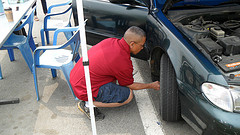You’ve emptied the trunk of golf clubs, backpacks, laundry, and that moldering dead body. You’ve shopped around for the best price for a tank of gas. You’ve formed a carpool. With gas prices soaring, what should a motorist do next to get the best fuel economy from their vehicle? The Automobile Club of Southern California says good driving, repair, and maintenance habits can help you achieve fuel savings of five percent or more based on average miles per gallon over 1,000 miles driven.

flic.kr/p/bXKk7C
“Making sure the vehicle is in good mechanical shape is one of the keys to getting the most mileage possible out of a tank of gas,” said the Auto Club’s Approved Auto Repair Program Manager Rick Kretsch. “And adjusting your driving style will also help with conserving gasoline. Your driving style significantly affects your fuel economy.”
Hey, we knew that, but here are some vehicle maintenance tips that might help stretch those precious gas dollars:
1. It’s all about the oil. Proper oil maintenance and viscosity will help your car to operate at maximum efficiency. Heavy (high viscosity) oil will cause the engine to work harder. Use the lightest grade oil for your climate and season. Check the chart in the owner’s manual to find out what grade is best suited to your vehicle.
2. Let your engine coolant be cool, but not too cool. Improperly mixed engine coolant can cause your engine to run too hot or too cool and can hamper fuel economy. The right temperature makes the car run more efficiently, so make sure your engine has fresh coolant in the right amount.
3. Replace the dirty air filter. An air filter works hard on freeways and roads and collects dust, dirt and debris. A new and functioning air filter will provide better gas mileage.
4. Fire up the spark plugs. A tune-up is a misnomer in this day in age. Computer-driven coil packs replaced the points, condenser and distributor in most vehicles a long time ago. However, spark plugs must fire properly for the engine to run smoothly. Replace the spark plugs on time, according to your owner’s manual.
5. Don’t ride around on big, big tires. For those who bought bigger tires and fancy wheels for SUV’s and mini-vans, it’s more than likely that fuel economy has significantly decreased. If you still have the original tires, think about switching them back. Consult the vehicle owner’s manual for the correct pressure.
6. Tires. Tires. Tires. Maintaining your vehicle’s tires is crucial to fuel economy, said Kretsch. Every other fill-up, walk around the vehicle and check tires for uneven or excessive tread wear as well as proper inflation. Refer to the vehicle’s doorjamb, fuel filler flap, or glove box for original equipment specifications or the manufacturer of the replacement tire for proper tire pressure inflation, he added. The Auto Club also recommends a tire rotation approximately every 7,500 miles. Check your owner’s manual for your specific vehicle’s service recommendations.
7. Service engine light. If the engine light is on, one or more systems in the vehicle aren’t working properly and can hamper fuel economy. Take the car into a reputable repair facility to be evaluated. Get a written estimate, if work is to be diagnosed.
8. Keep it not so cool. Use your air conditioner sparingly and consider sitting on ice cubes instead.
9. Don’t stomp on the accelerator. How hard you depress the throttle will greatly affect fuel economy. Accelerate less aggressively, brake gently, and stop speeding. Instead of driving defensively, adopt a more fuel-efficient driving style.
Tagged with: fuel savings • maintenance tips
Filed under: Car Maintenance